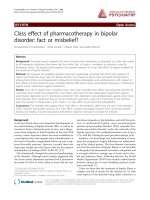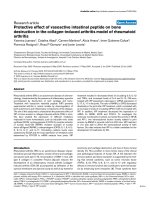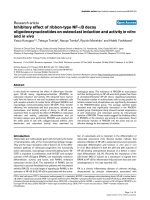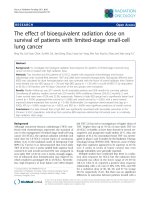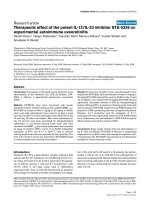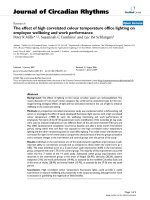Báo cáo y học: " Inhibitory effect of small interfering RNA on dengue virus replication in mosquito cells" ppsx
Bạn đang xem bản rút gọn của tài liệu. Xem và tải ngay bản đầy đủ của tài liệu tại đây (818.91 KB, 8 trang )
RESEARC H Open Access
Inhibitory effect of small interfering RNA on
dengue virus replication in mosquito cells
Xinwei Wu
1,2†
, Hua Hong
3†
, Jinya Yue
1,4
, Yejian Wu
1
, Xiangzhong Li
1
, Liyun Jiang
1
, Lei Li
4
, Qiaoyan Li
4
,
Guoquan Gao
4,5*
, Xia Yang
2,4*†
Abstract
Background: Dengue viruses (DENs) are the wildest transmitted mosquito-borne pathogens throughout tropical
and sub-tropical regions worldwide. Infection with DENs can cause severe flu-like illness and potentially fatal
hemorrhagic fever. Although RNA interference triggered by long-length dsRNA was considered a potent antiviral
pathway in the mosquito, only limited studies of the value of small interfering RNA (siRNA) have been conducted.
Results: A 21 nt siRNA targeting the membrane glycoprotein precursor gene of DEN-1 was synthesized and
transfected into mosquito C6/36 cells followed by challenge with DEN. The stability of the siRNA in cells was
monitored by flow cytometry. The antiviral effect of siRNA was evaluated by measurement of cell survival rate
using the MTT method and viral RNA was quantitated with real-time RT-PCR. The presence of cells containing
siRNA at 0.25, 1, 3, 5, 7 days after transfection were 66.0%, 52.1%, 32.0%, 13.5% and 8.9%, respectively. After 7 days
incubation with DEN , there was reduced cytopathic effect, increased cell survival rate (76.9 ± 4.5% vs 23.6 ± 14.6%)
and reduced viral RNA copies (Ct value 19.91 ± 0.63 vs 14.56 ± 0.39) detected in transfected C6/36 cells.
Conclusions: Our data showed that synthetic siRNA against the DEN-1 membrane glycoprotein precursor gene
effectively inhibited DEN-1 viral RNA replication and increased C6/36 cell survival rate. siRNA may offer a potential
new strategy for prevention and treatment of DEN infection.
Background
Dengue viruses (DENs) are the wildest transmitted arbo-
virus members of the family Flaviviridae,genusFlavi-
virus, and compose four serotypes, DEN-1, 2, 3, and 4.
As the etiologic agents, DENs can cause severe flu-like
illness called dengue fever (DF), and sometimes lethal
complication called dengue haemorrhagic fever (DHF)
and dengue shock syndrome (DSS) [1,2]. They transmit
diseases to human beings primarily through mosquitoes,
mainly Aedes aegypti and Aedes albopictus. With drama-
tically growth in recent decades, DF affects 100 million
people and results in about 25,000 deaths annually,
mostly in tropical and sub-tropical regions. DHF has
become a leading cause of serious illness and death
amongchildreninsomeAsiancountries[3].Unfortu-
nately, effective vaccines or therapies against the infec-
tion are still not available [4].
RNA interference (RNAi) is a sequence-specific R NA
degradation process in the cytoplasm of eukaryotic cells
triggered by double-stranded RNA (dsRNA), widely exist-
ing in many species f rom ne matode to huma n [5-8].
Upon introduction into the cells, exogenous dsRNAs are
cut into 21-25 nt small interfering RNA (siRNA) by an
RNase III-like enzyme called Dicer. The siRNAs form
RNA-induced silencin g complex (RISC) with other cellu-
lar components, and lead to the cleavage of their homo-
logous transcript and eventually the silencing of specific
gene [9-11 ]. RNAi is believed to be an effective endogen-
ous mechanism for h ost cells to defense against virus
attack [12], and has been applied as an exogenous mea-
sure to inhibit viral replication, such as HIV [13,14],
influenza A virus [15], HBV [16] and SARS-CoV [17].
DEN is one of the first animal viruses that could be effi-
ciently inhibited by RNAi [12,18]. Like other fl aviviruses,
DEN generates intracellular dsRNA as an intermediate of
* Correspondence: ;
† Contributed equally
2
Key Laboratory of Functional Molecules from Marine Microorganisms (Sun
Yat-sen University), Department of Education of Guangdong Province, 74
Zhongshan 2nd Road, Guangzhou, Guangdong 510080, China
4
Department of Biochemistry, Zhongshan Medical School, Sun Yat-sen
University, 74 Zhongshan 2nd Road, Guangzhou, Guangdong 510080, China
Full list of author information is available at the end of the article
Wu et al. Virology Journal 2010, 7:270
/>© 2010 Wu et al; licensee BioMed Central Ltd . This is an Open Access article distributed under the terms of the Creative Commons
Attribution License ( nses/by/2.0), which permits unrestricted use, distri bution, and reproduct ion in
any medium, provided the original work is properly cited.
their replication, which may induce RNAi in the host cells.
A new explanation for mosquitoes’ non-pathogenic and
persistent infections of DEN is that RNAi could be an
important modulator [19]. Exogenous long length dsRNA
corresponding to DEN sequences, introduced by either
plasmid or Sindbis viruses, has been proven t o mediate
RNAi in mosquito C6/36 Cells and lead to inhibition of
DEN replication in cultured mosquito cells [20,21].
Genetica lly modifi ed Aedes aegypti has been raised to
develop dengue virus resistance [22-24]. The mixtures of
DEN s pecific small interfering RNAs, the hallmark of
RNAi, were detected in all aforementioned studies. But lit-
tle was known about the role of single siRNA with particu-
lar target sequence in the inhibition of DEN replication.
Our present study was designed to investigate if a single
siRNA has the inhibitory effect on DEN-1 replication in
mosquito cells.
Results
Determination of effective siRNA sequence
Four siRNA sequences (table 1) against different parts of
the DEN-1 genome were designed according to the gene
sequences of DEN-1 epidemic strain GZ02-218 from
Guangzhou City, China 2002(GenBank access No.
EF079826), and DEN-1 reference strain (GenBank access
No. EU848545). Only one siRNA (DenSi-1) transfected
cells showed reduced CPE(< +) after 7 days post-infec-
tion (dpi), others showed ++++ CPE, as virus positive
control cells did(Figure 1). DenSi-1 was selected for
further investigation.
Effects of siRNA on C6/36 survival to DEN challenge
CPE in each group was observed at the 7
th
dpi. The virus
positive control group and control siRNA group showed
a large number of CPE up to ++++, characterized by cell
swelling and fusing, and reduced cell number; whi le nor-
malgroupandsiRNAgroupshowednoCPEandno
observable decrease in cell number. The cell survival rate
of C6/36 cells , measured by MTT assay, of siRNA group
was 76 .9% ± 4.5%, control-siRNA group was 43.9% ±
3.6%, and virus positive control group was 23.6% ±
14.6%. Compared wit h virus pos itive control group, the
cell survival rate of siRNA group increased by 2.26-fold
(n = 5, P < 0.05), but siRNA control group showed no
significant difference (n = 5, P > 0.05) (Figure 2).
Effects of siRNA on viral loading in infected C6/36 cells
The amount of intracellular DEN-1 viral loading was
detected by Real time RT-PCR at the 7
th
dpi. The CT
value of DEN-1 RNA of siRNA group was 19.91 ± 0.63,
control-siRNA group was 14.63 ± 0.91, virus-positive
control group was 14.56 ± 0.39, and no viral RNA
detectable in normal control group. Compared with the
virus positive control group, siRNA group showed sig-
nificant decrease of viral loading (n = 5, P < 0.0 5), but
control siRNA group showed no significant difference (n
=5,P>0.05)(table2).TheviralRNAamountof
siRNA group was reduced for 2
5.34
fold (about 40 fold),
the inhibition rate was 97.54%.
siRNA transfection efficiency and stability
Aft er transfection with FAM-labeled siRNA, fluorescent
signals can be detected in more than half of C6/36 cells
cytoplasm under a fluorescent microscope. During the
incubation, the fluorescent intensity in the cells gradu-
ally decreased (Figure 1). And the percentage of FAM
positive cell at 6 h, days 1, 3, 5, and 7 were 66.0%,
52.1%, 32.0%, 13.5%, and 8.9%, respectively, by flow
cytometry (Figure 3).
Discussion
As a rapid developing technology, RNAi has not only
become a powerful tool for studying gene function and
development of gene-based therapies, but also been
widely used in anti-virus researches. Precious studies
suggested that, at the molecular, cellular and individual
levels, RNAi can potentially be used to block viral trans-
mission and thus prevent the viral diseases [12,18]. With
the high efficiency, specificity and low cytotoxicity,
RNAi offered a new promise of anti-viral therapy.
For ssRNA viruses such as DEN, there genomes are
exposed within cytoplasm and become potential targets
for RNAi. This likely happened at the moment between
the uncoating of viral RNA and the viral replication
[25]. Virus resistance has been proven to be generated
by RNAi triggered from exogenous DEN-specific
dsRNA. Adelman et al. [20] showed this resis tance by a
290 nt dsRNA homologous to the typ e II dengue virus
PrM gene which was expressed by plasmid, in cultured
mosquito C6/36 cells. Travanty et al. [ 23] developed
transgenic mosquito lines that transcribed the same 290
nt dsRNA with i nsect promoters, but failed to express
in critical site for DEN replication such as midguts.
Franz et al. [24] increased the size of dsRNA to 578 nt
and succeeded in midgut expression and viral transmis-
sion diminishing. In addition to DEN-2, alternation of
Table 1 sequences and positions of designed siRNA
No Sequence(5’-3’) Position
DenSi-1 AACGGAACCAGAUGACGUUGA 432
DenSi-2 AACUGUGCAUUGAAGCCAAAA 929
DenSi-3 AACAGGGCUAGACUUCAAUGA 1320
DenSi-4 AAGAAGAAUGGAGCGAUCAAA 133
control siRNA UUCUCCGAACGUGUCACGUdT –
Four siRNA sequences (table 1) against different parts of the DEN-1 genome
were designed, the positions refered to DEN-1 reference strain (GenBank
access No. EU848545). Negative siRNA was supplied by HiPerFect Transfection
Reagent kit (Qiagen, German)
Wu et al. Virology Journal 2010, 7:270
/>Page 2 of 8
the replication kinetics of DEN-1 has also proven to be
triggered by dsRNA in C6/36 cells [26].
However, long dsRNA fragments are associate d with
higher cost in synthesis, poorer stability, and raise the
chance for mismatch rate. At the same time, introduc-
tion of dsRNAs longer than 30 base pairs into mamma-
lian cells will activate the potent interferon and protein
kinase R antiviral pathways, resulting in non-sequence-
specific effects that can include apoptosis [27]. There-
fore, thes e disadvantages largely restrict the use of long
dsRNA in pre-clinical and clinical applications.
siRNAs are degraded products of d sRNA with 21-25 nt i n
length, and have no such disadvantages b ecause of their
short length. They are also described as “hallmark ” of RNAi
in all previously published papers. We hypotheses that the
siRNA derived from the same fraction can have the same
inhibitory effect as the dsRNA did. There fore, in this study,
we designed and synthesized 21 nt siRNAs against the
DEN-I viral PrM gene, and investigated t heir inhibition
effects of d engue virus re plication in transfected C6/36 cells.
In four siRNAs we designed, only one showed the f unction
to reduce CPE after DEN infection. As expected, the loca-
tion of this siRNA in DEN-1 is inside the corresponding
location of 290 nt d sRNA reported before in DEN-2.
With transfection of the selected siRNA, C6/36 cells
showed reduced CPE, and increased cell survival by 2.26
folds and eliminated viral RNA by about 97.54% compared
to virus infection only group, at the 7
th
dpi. These d ata
indicate that siRNA against DEN viral genome can effec-
tively inhibit viral RNA replication in the C6/36 cells, pro-
tect host cell from viral attack, suggesting its potential role
in prevention and treatment of dengue fever.
Figure 1 CPE Difference in C6/36 cells transfected with four siRNAs. Four siRNA were transfected into C6/36 cells which were challenged by
DEN-1. Only DenSi-1 (B) transfected cells showed less CPE(< +) at 7 dpi than cells transfected with other siRNAs. A: normal control group; B-E:
siRNA treatment group (transfected with DenSi-1-4); F: siRNA control group; G: positive control group
Wu et al. Virology Journal 2010, 7:270
/>Page 3 of 8
Figure 2 Effects of siRNA on C6/36 cell survival rate. C6/36 cells were transfected with DenSi-1(B) or control siRNA(C), and challenged by
DEN-1(B-D). CPEs were observed and cell survival rates were measured by MTT assay at the 7
th
dpi. Compared with virus positive control group,
the cell survival rate of siRNA group increased by 2.26-fold (n = 5, P < 0.05), but siRNA control group showed no significant difference (n = 5, P
> 0.05) A: normal control group; B: siRNA treatment group; C: siRNA control group; D: virus positive control group; Up: CPEs of C6/36 cells at the
7th dpi; Down: MTT assay results for C6/36 cells survival rate at the 7th dpi (n = 5). * P < 0.05, compared with virus positive control group.
Wu et al. Virology Journal 2010, 7:270
/>Page 4 of 8
Table 2 DEN-1 viral RNA load in C6/36 cells at the 7
th
dpi (n = 5)
Normal control group siRNA group Control siRNA group Positive control group
CT value Negative 19.91 ± 0.63* 14.63 ± 0.91 14.56 ± 0.39
ΔCT value – 5.34 0.07 –
* P < 0.05, Compared with the virus positive control group
The amount of intracellular DEN-1 vira l loading was measured by Real time RT-PCR at the 7
th
dpi.
Figure 3 Stability of transfected siRNA in C6/36 cells. A: C6/C36 cells were transfected with 1.0 μg FAM-labeled DenSi-1 and cultured for 7
days. FAM fluorescence in the cells was observed under fluorescence microscope(×200); B: C6/36 cells transfected with FAM-labeled siRNAs were
harvested at different time points as indicated, washed and resuspended with PBS (pH7.4). FAM fluorescence was quantified by flow cytometry
and the percentage of fluorescence positive cells was measured. The rates of C6/36 cells containing FAM-labeled siRNA at 6 hours, 1, 3, 5, and 7
dpi were 66.0%, 52.1%, 32.0%, 13.5% and 8.9%, respectively.
Wu et al. Virology Journal 2010, 7:270
/>Page 5 of 8
Recentstudyhaveshown[19]thatAedes aegypti can
produce dsRNAs homologous to dengue viral genes and
trigger an intrinsic siRNA anti-viral action, but this
endogenous anti-viral mechanism can not effectively
inhibit the replication of dengue virus. Data presented
in our study revealed that exogenous siRNA in Aedes
albopictus cells is effective in inhibiting viral DNA repli-
cation. Therefore, it is possible that the anti-viral
mechanisms mediated by exogenous and endogenous
siRNAs may act synergistically in the protection of cells
from viral a ttacks, although this hypothesis needs
further researches to prove.
Because the short siRNAs are unstable inside the
cells, and also diluted by continuous cell division, the
siRNA contents in the cells decline over time resulting
in the weakening of interference effect. From the data
in this study, siRNAs can be successfully transfected
into 66% of the cells but this percentage gradually
reduced with time and siRNA molecules only retained
in 8.9% of the cells at the seventh day post transfec-
tion. Therefore, maintaining the continuity of RNA
interference is crucial for the promot ion and applica-
tion of RNAi technology. Alternative form of vectors,
such as retrovirus[28] and nano device[29], will be
applied in the future.
Since currently there are no effective therapies or vac-
cines against Dengue fever, the use of RNAi to suppress
dengue virus replication and protect cells from viral
attacks will undutiful provide a new research strategy
for the prevention and treatment of this disease.
Conclusions
Our data showed that synthetic siRNA against the DEN
membrane glycoprotein precursor gene effectively inhib-
ited DEN viral RNA replication and in creased C6/36
cell survival rate. siRNA may offer a potential new st rat-
egy for prevention and treatment of DEN infection . The
stability and inhibitory efficiency of si RNA need further
improvement in the future.
Methods
1. Cell culture and virus replication
Type 1 DEN strain GZ02 -218 and Aedes albop ictus C6/
36 cell line were both from the Department of Virolo-
gy&Immunology in Guangzhou Center for Disease Con-
trol and Prevention. C6/36 cells were grown at 28°C, in
Eagle’s minimal essential medium (MEM, Gibco, USA)
supplemented with 10% fetal bovine serum (FBS, Gibco,
USA), 100 μg/mL penicillin a nd streptomycin, pH 7.4
(maintain medium). Cells were passaged every 5 to 7
days to maintain exponential growth. DEN-1 strain
GZ02-218 was passaged by infecting monolayers of C6/
36 cells and viruses were harvested at 12-14 days.
TCID
50
of virus was measured for viral challenge.
2. siRNA design and synthesis
FourpairsofsiRNAsagainstdif ferent parts DEN-1 viral
genome were designed online (Qiagen, German) based
on the common sequences of the epidemic strain GZ02-
218inGuangzhouCityofChinain2002(GenBank
access number EF079826), DE N-1 reference virus stra in
(GenBank access number EU8 48545), and other DEN
strains. Four siRNA fragments (DenSi-1~4) were synthe-
sized and purified by PAGE electrophoresis (Ambion,
USA). siRNAs was also labeled with FAM and purified
forvisualizationaftertransfection (Ambion, U SA). A
siRNA fragment inconsistent containing sequence with
DEN was used as the negative control (Qiagen, German).
3. Experimental groups
C6/36 cells were cultured in 24-well plate and divided
into the following four groups based on different treat-
ments: normal control group(A): cells received no
siRNA transfection or viral infection; siRNA treatment
group(B): cells transfected with siRNA and subsequently
challenged by DEN-1 (GZ02-218); siRNA control group
(C): ce lls transfected with the control siRNA having no
common sequence with dengue virus genome and chal-
lenged by DEN-1; and virus positive control group(D):
cells r eceived no siRNA transfection but directly chal-
lenged by DEN-1. Every group contained 6 wells of cells.
4. siRNA transfection and viral infection
C6/36 cells were cultured in maintain medium at 28°C,
and then inoculated in 24 well pla tes at 1 × 10
6
/well in
0.5 ml medium the day before transfection. When 80%
~ 90% cells grew into monolayer, they were transfected
with siRNA molecules according to the manual for
HiPerFect Transfection Reagent kit (Qiagen, German).
1.0 μgsiRNAand3μl HiPerFect Transfection Reagent
were used for each well. After c ultured at 28°C for 4
hours, the medium with transfection reagent was
removed. Cells were washed by MEM, challenged by
100 TCID
50
DEN-1 and cultured at 33°C in maintain
medium for further investigation.
5. CPE effects of Dengue virus on C6/36 cells
The cytopathic effect (CPE) of DEN-1 infection on C6/
36 cells, including cell rounding, syncytium formation
and cell death, was evaluated under a light microscope,
and scored based on the severity from 0 (no CPE
observed, no cell death) to the most severe level ++++
(CPE observed in 100% cells).
6. MTT assay for cell survival rate
At the 7
th
dpi, MTT assay was applied to measure cell
viabili ty. 100 μl MTT was added to every well and incu-
bated for 4 hours then replaced with 1 ml DMSO. The
24-well plate was shaken at 37°C for 10 minutes and
Wu et al. Virology Journal 2010, 7:270
/>Page 6 of 8
OD
490
of every well was obtained in a microplate reader.
The OD value obtained from the normal control group
was set as 100% viability, and the cell survival rate of
other groups was calculated as their respective OD
value divided by that of the control group.
7. Real-time RT-PCR detection of dengue virus RNA in C6/
36 cells
At the 7
th
dpi, C6/36 cells wer e collected and viral RNA
was isolated with QIAamp Viral RNA Extraction Kit
(Qiagen, German), and quantified with the dengue virus
real-time fluorescent RT-PCR detection kit (Shenzhen
Taitai Genomics, China). PCR reaction conditions were:
one cycle of 50°C for 30 min a nd 95°C for 3 min, then
40 cycles of 95°C for 5 sec and 60°C for 40 sec. The
relative amount of viral load in each group was repre-
sented by CT value, and the changes betwee n groups
were calculated by comparative CT (ΔCT) values.
8. Transfection efficiency and stability of siRNA
C6/36 cells were transfected with FAM-labeled siRNAs
and cultured for 7 days. Fluorescence signal was
observed under fluorescence microscope at 6 hours, 1,
3, 5, and 7 days. Cells were harvested at every time
point, and measured by flow cytometry. siRNA positive
cell rate was calculated as the percentage of cells con-
taining fluorescent signals.
9. Statistical analysis
All values were presente d as mean ± S.D. Statistical sig-
nificance was evaluated using the two-tailed Mann-
Whitney U-test; P < 0.05 was considered significant.
Acknowledgements
This study was supported by National Nature Science Foundation of China,
Grant Number: 30872980, 30971208, 30973449; National Key Sci-Tech Special
Project of China, Grant Number: 2008ZX10002-019, 2009ZX09103-642; Team
Project of Nature Science Foundation of Guangdong Province, China, Grant
Number: 06201946; Key Project of Nature Science Foundation of Guangdong
Province, China, Grant Number: 10251008901000009; Sci-tech Research
Project of Guangdong Province, China, Grant Number: 2008B030303041; Key
Sci-tech Research Project of Guangzhou Municipality, China, Grant Number:
2006J1-C0141, 2008J1-C191, 2008Z1-E231; Medical Science and Technology
Key Research Projects of Guangzhou Municipality, China, Grant Number:
2006-ZDi-10, 2008-ZDi-12. Program for Young Teacher in University, China,
Grant Number: 10YKPY28.
Author details
1
Guangzhou Center for Disease Control and Prevention, 23 Zhongshan 3rd
Road, Guangzhou, Guangdong 510080, China.
2
Key Laboratory of Functional
Molecules from Marine Microorganisms (Sun Yat-sen University), Department
of Education of Guangdong Province, 74 Zhongshan 2nd Road, Guangzhou,
Guangdong 510080, China.
3
Department of Neurology, The first hospital
affiliated SunYat-sen University, 74 Zhongshan 2nd Road, Guangzhou,
Guangdong 510080, China.
4
Department of Biochemistry, Zhongshan
Medical School, Sun Yat-sen University, 74 Zhongshan 2nd Road,
Guangzhou, Guangdong 510080, China.
5
China Key Laboratory of Tropical
Disease Control (Sun Yat-sen University), Ministry of Education, Guangzhou
510080, China.
Authors’ contributions
WX and HH performed majority of the experiments and wrote the part of
material and methods. YJ, WY and LX performed siRNA transfection
experiments. JL, LL and LQ cooperated on cell and virus cultures. YX and GG
designed the experiments and wrote the manuscript. All authors read and
approved the final manuscript.
Competing interests
The authors declare that they have no competing interests.
Received: 17 August 2010 Accepted: 14 October 2010
Published: 14 October 2010
References
1. WHO: World Health Organization: Dengue and Dengue Haemorrhagic
Fever. Fact Sheet No. 117. Geneva 2009.
2. Kyle JL, Harris E: Global spread and persistence of dengue. Annu Rev
Microbiol 2008, 62:71-92.
3. Halstead SB: Dengue virus-mosquito interactions. Annu Rev Entomol 2008,
53:273-291.
4. Whitehead SS, Blaney JE, Durbin AP, Murphy BR: Prospects for a dengue
virus vaccine. Nat Rev Microbiol 2007, 5(7):518-528.
5. Fire A, Xu S, Montgomery MK, Kostas SA, Driver SE, Mello CC: Potent and
specific genetic interference by double-stranded RNA in Caenorhabditis
elegans. Nature 1998, 391:806-811.
6. Montgomery MK, Xu S, Fire A: RNA as a target of double-stranded RNA
mediated genetic interference in Caenorhabditis elegans. Proc Natl Acad
Sci USA 1998, 95:15502-15507.
7. Elbashir SM, Lendeckel W, Tuschl T: RNA interference is mediated by 21-
and 22-nucleotide RNAs. Genes Dev 2001, 15:188-200.
8. Chiu YL, Rana TM: RNAi in human cells: basic structural and functional
features of small interfering RNA. Molecular Cell 2002, 10(3):549-561.
9. Hammond SM, Bernstein E, Beach D, Hannon GJ: An RNA-directed
nuclease mediates post transcriptional gene silencing in Drosophila
cells. Nature 2000, 404(6775):293-296.
10. Meister G, Tuschl T: Mechanisms of Gene Silencing by Double-Stranded
RNA. Nature 2004, 431(7006):343-349.
11. Mello CC, Conte D Jr: Revealing the World of RNA Interference. Nature
2004, 431(7006):338-342.
12. Haasnoot PC, Cupac D, Berkhout B: Inhibition of virus replication by RNA
interference. J Biomed Sci 2003, 10(6 Pt 1):607-616.
13. Song E, Lee SK, Dykxhoorn DM, Novina C, Zhang D, Crawford K, Cerny J,
Sharp PA, Lieberman J, Manjunath N, Shankar P: Sustained small
interfering RNA-mediated human immunodeficiency virus type 1
inhibition in primary macrophages. J Virol 2003, 77(13):7174-7181.
14. Lee SK, Dykxhoorn DM, Kumar P, Ranjbar S, Song E, Maliszewski LE,
François-Bongarçon V, Goldfeld A, Swamy NM, Lieberman J, Shankar P:
Lentiviral delivery of short hairpin RNAs protects CD4 T cells from
multiple clades and primary isolates of HIV. Blood 2005, 106(3):818-826.
15. Sui HY, Zhao GY, Huang JD, Jin DY, Yuen KY, Zheng BJ: Small interfering
RNA targeting m2 gene induces effective and long term inhibition of
influenza A virus replication. PLoS One 2009,
4(5):e5671.
16. Tang KF, Chen M, Xie J, Song GB, Shi YS, Liu Q, Mei ZC, Steinle A, Ren H:
Inhibition of hepatitis B virus replication by small interference RNA
induces expression of MICA in HepG2.2.15 cells. Med Microbiol Immunol
2009, 198(1):27-32.
17. Shi Y, Yang DH, Xiong J, Jia J, Huang B, Jin YX: Inhibition of genes
expression of SARS coronavirus by synthetic small interfering RNAs. Cell
Res 2005, 15(3):193-200.
18. Sánchez-Vargas I, Travanty EA, Keene KM, Franz AW, Beaty BJ, Blair CD,
Olson KE: RNA silencing, Arthropod-borne virus and mosquitoes. Virus
Research 102:65-74.
19. Sánchez-Vargas I, Scott JC, Poole-Smith BK, Franz AW, Barbosa-Solomieu V,
Wilusz J, Olson KE, Blair CD: Dengue virus type 2 infections of Aedes
aegypti are modulated by the mosquito’s RNA interference pathway.
PLoS Pathog 2009, 5(2):e1000299.
20. Adelman ZN, Sanchez-Vargas I, Travanty EA, Carlson JO, Beaty BJ, Blair CD,
Olson KE: RNA Silencing of Dengue Virus Type 2 Replication in
Transformed C6/36 Mosquito Cells Transcribing an Inverted-Repeat RNA
Derived from the Virus Genome. J Virol 2002, 76(24):12925-12933.
Wu et al. Virology Journal 2010, 7:270
/>Page 7 of 8
21. Adelman ZN, Blair CD, Carlson JO, Beaty BJ, Olson KE: Sindbis Virus-
Induced Silencing of Dengue Viruses in Mosquitoes. Insect Mol Biol 2001,
10(3):265-273.
22. Olson KE, Adelman ZN, Travanty EA, Sánchez-Vargas I, Beaty BJ, Blair CD:
Developing arbovirus resistance in mosquitoes. Insect Biochem Mol Biol
2002, 32:1333-1343.
23. Travanty EA, Adelman ZN, Franz AW, Keene KM, Beaty BJ, Blair CD,
James AA, Olson KE: Using RNA interference to develop dengue virus
resistance in genetically modified Aedes aegypti. Insect Biochem Mol Biol
2004, 34:607-13.
24. Franz AW, Sanchez-Vargas I, Adelman ZN, Blair CD, Beaty BJ, James AA,
Olson KE: Engineering RNA interference-based resistance to dengue
virus type 2 in genetically modified Aedes aegypti. Proc Natl Acad Sci USA
2006, 103(11):4198-4203.
25. Uchil PD, Satchidanandam V: Architecture of the flaviviral replication
complex. J Biol Chem 2003, 278(27):24388-24398.
26. Caplen NJ, Zheng Z, Falgout B, Morgan RA: Inhibition of viral gene
expression and replication in mosquito cells by dsRNA-triggered RNA
interference. Mol Ther 2002, 6:243-251.
27. Kumar M, Carmichael GG: Antisense RNA function and fate of duplex
RNA in cells of higher eukaryotes. Microbiol Mol Biol Rev 1998,
62:1415-1434.
28. Nakamura Y, Kogure K, Futaki S, Harashima H: Octaarginine-modified
multifunctional envelope-type nano device for siRNA. J Control Release
2007, 119(3):360-7.
29. Nawtaisong P, Keith J, Fraser T, Balaraman V, Kolokoltsov A, Davey RA,
Higgs S, Mohammed A, Rongsriyam Y, Komalamisra N, Fraser MJ Jr:
Effective suppression of Dengue fever virus in mosquito cell cultures
using retroviral transduction of hammerhead ribozymes targeting the
viral genome. Virol J 2009, 6(73).
doi:10.1186/1743-422X-7-270
Cite this article as: Wu et al.: Inhibitory effect of small interfering RNA
on dengue virus replication in mosquito cells. Virology Journal 2010
7:270.
Submit your next manuscript to BioMed Central
and take full advantage of:
• Convenient online submission
• Thorough peer review
• No space constraints or color figure charges
• Immediate publication on acceptance
• Inclusion in PubMed, CAS, Scopus and Google Scholar
• Research which is freely available for redistribution
Submit your manuscript at
www.biomedcentral.com/submit
Wu et al. Virology Journal 2010, 7:270
/>Page 8 of 8



